选择如何在公园空间中与他人互动的能力,及其在安全感和偏好方面的作用
IF 6.1
1区 心理学
Q1 ENVIRONMENTAL STUDIES
引用次数: 0
摘要
城市公园作为有利于社会交往的空间受到人们的喜爱,但人们较少从公园可能满足隐私需求的角度来考虑它们。目前还缺乏研究来检验公园的各种空间特征(包括植被特征)对满足这种需求的影响,并解释这种影响的机制,包括安全感所起的作用。我们在三个模型中测试的关键变量是选择是否在公园空间中与他人互动的能力。我们测试了两个假设。在第一个假设中,我们检验了选择与他人交流的能力和安全感是否是变量,可以解释构成公园空间观赏障碍(高和中)的绿化数量如何影响人们的偏好。第二个假设认为,安全感可以解释所期望的私密性和在公园空间中选择与他人进行社交互动的能力如何以及为什么会影响对该空间的偏好。我们分析了变量之间的相关性和中介效应。为此,我们采用了被试内设计,让 243 名参与者根据安全感、期望的私密性、景观偏好和选择与他人互动的能力,对一组 120 张公园景观照片进行评价。我们通过分析一些中介模型来检验假设。两个假设都得到了部分证实。绿化数量与偏好之间的正相关关系是由在特定空间中选择与他人互动的能力所中介的,而不是因为安全性。同时,安全通过削弱期望的私密性对偏好的积极影响来解释这种影响,但不能解释互动选择对偏好的影响。这就意味着,提供互动选择的空间更受青睐--而这些空间可能会降低安全性这一事实并不重要。本文章由计算机程序翻译,如有差异,请以英文原文为准。
The ability to choose how to interact with other people in the park space and its role in terms of perceived safety and preference
City parks are appreciated as spaces conducive to social interactions, but they are less often considered in the context that they might satisfy a need for privacy. There is a lack of research that tests the impact of various spatial features of parks (including vegetation features) on fulfilling this need and explaining the mechanisms of such impact, including the role played by sense of safety. This article fills this research gap.
The key variable whose role we tested in three models was the ability to choose whether or not to interact with other people in a park space. We tested two hypotheses. In the first, we checked whether the ability to choose to interact with other people and sense of safety are variables, that explains how the quantity of greenery constituting a viewing obstruction (high and medium) in a park space impacts preference. The second hypothesis assumed that safety explains how and why desired privacy and the ability to choose social interactions with other people in a park space affect preferences towards this space. We analysed correlations between variables and mediating effects. For this purpose, we employed a within-subjects design in which 243 participants evaluated a set of 120 eye-level photographs of park landscapes according to perceived safety, desired privacy, landscape preference and the ability to choose to interact with other people. We calculated the quantity of greenery in the photos as the percentage coverage of the frame with high and medium greenery.
We tested the hypotheses by analysing a number of mediation models. Both hypotheses were partially confirmed. The positive relationship between quantity of greenery and preferences is mediated by the ability to choose to interact with other people in a given space but not because of safety. At the same time, safety explains the positive impact of desired privacy on preferences by weakening it, but does not explain the impact of interaction choice on preferences. This means, inter alia, that spaces offering a choice of interactions are preferred – and the fact that they may be accompanied by reduced safety is not significant.
求助全文
通过发布文献求助,成功后即可免费获取论文全文。
去求助
来源期刊

Journal of Environmental Psychology
Multiple-
CiteScore
10.60
自引率
8.70%
发文量
140
审稿时长
62 days
期刊介绍:
The Journal of Environmental Psychology is the premier journal in the field, serving individuals in a wide range of disciplines who have an interest in the scientific study of the transactions and interrelationships between people and their surroundings (including built, social, natural and virtual environments, the use and abuse of nature and natural resources, and sustainability-related behavior). The journal publishes internationally contributed empirical studies and reviews of research on these topics that advance new insights. As an important forum for the field, the journal publishes some of the most influential papers in the discipline that reflect the scientific development of environmental psychology. Contributions on theoretical, methodological, and practical aspects of all human-environment interactions are welcome, along with innovative or interdisciplinary approaches that have a psychological emphasis. Research areas include: •Psychological and behavioral aspects of people and nature •Cognitive mapping, spatial cognition and wayfinding •Ecological consequences of human actions •Theories of place, place attachment, and place identity •Environmental risks and hazards: perception, behavior, and management •Perception and evaluation of buildings and natural landscapes •Effects of physical and natural settings on human cognition and health •Theories of proenvironmental behavior, norms, attitudes, and personality •Psychology of sustainability and climate change •Psychological aspects of resource management and crises •Social use of space: crowding, privacy, territoriality, personal space •Design of, and experiences related to, the physical aspects of workplaces, schools, residences, public buildings and public space
 求助内容:
求助内容: 应助结果提醒方式:
应助结果提醒方式:


